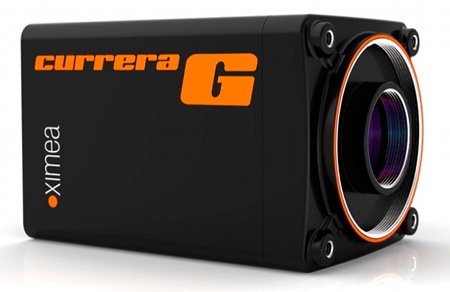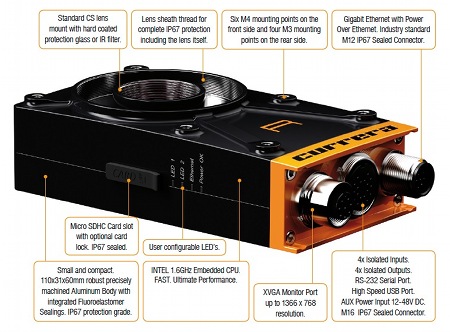Linux-ready camera gets dual-core AMD G-Series processor
Aug 23, 2011 — by LinuxDevices Staff — from the LinuxDevices Archive — 1 viewsXimea GmbH announced new “smart cameras” that include AMD G-Series processors and monochrome or color image sensors ranging from WVGA (752 x 480 pixels) to five megapixels. The Currera-G devices include flash storage, microSD slots, VGA and Ethernet ports, and isolated digital I/O, the company says.
Ximea has for several years offered monochrome Currera-R smart cameras — with built-in Intel Atom processors — and introduced color versions of the devices in May. The devices compete with Matrox's similarly Atom-powered Iris GT cameras, which migrated from black-and-white to color and most recently gained a five megapixel upgrade.
A key difference from the Iris GT cameras is that Matrox's offerings are designed to run machine vision application created using the company's own Matrox Design Assistant IDE (integrated development environment). Ximea says the Currera cameras are, in contrast, designed to be more platform-agnostic. In addition, whereas the Matrox cameras are Windows only, the Currera-G runs Linux, as well as Windows Embedded Standard 7, Windows Embedded Standard 2009, and Windows XP SP3. The camera's software package includes a software development kit, GenTL, a LabVIEW demo, an OpenCV demo, a libdmtx demo, an Aforge.NET framework demo, an Integrating Vision Toolkit demo, a Halcon demo, and a Cognex demo, the company adds.
Supported software is said to include the following, with others on the way:
- Cognex VisionPro
- MathWorks MATLAB
- Matrox MIL
- MVTec Halcon
- National Instruments LabVIEW
- NeuroCheck
- OpenCV, Intel IPP
- Open source lib_dmtx
- Open source AForge.NET
- Open source Integrating Vision Toolkit, Keyetech
- RoboRealm
- Stemmer Imaging Common Vision Blox
- Tordivel Scorpion
Previous Currera-R models, which are still on sale, are available with a 1.6GHz Atom Z530 or a 1.1GHz Atom Z510. The Z510 model includes 512MB of RAM and 1GB of flash storage, while the Z530 model has 1GB of RAM and 4GB of flash, the company adds.

Ximea's Currera-G
(Click to enlarge)
Now, though, Ximea has added a Currera-G model (above) with more processing power, more random access memory, and more storage. The upgraded smart camera employs AMD's G-Series T56N processor clocked at 1.6GHz, offers 2GB of RAM, and has 8GB of SSD (solid state disk) storage, according to the company.
Despite the more powerful processor — featuring dual x86 cores, on-chip integrated Radeon HD6320 graphics, and an 18-Watt TDP — the Currera-G remains operable via PoE (power over Ethernet), Ximea says. Power consumption ranges from 12 to 25 Watts, the company adds.
According to Ximea, the Currera-G includes dual microSD slots, like the Currera-R. It also includes gigabit Ethernet, USB, an RS232 port, a VGA output, eight isolated digital inputs and outputs, programmable current-controlled output for LED lighting, and graphically configurable real-time PLC, the company adds.

Ports on the Currera-R
(Click to enlarge)
Ximea did not provide a data sheet, but we're assuming the Curerra-G employs sealed M12 and M16 connectors, like the Currera-R (above). The smart camera is said to be cooled by a "solid state microblower."
Further information
Ximea did not release pricing or availability details for the Currera-G. Presumably, it will be a bit more expensive than the -R, whose prices range from 1,900 Euros (about $2,700) for a Z510-powered camera with a monochrome VGA sensor, to 2,800 Euros (about $3,975) for a Z530-equipped version with a five megapixel color sensor. More information should become available on the Currera product page.
Jonathan Angel can be followed at www.twitter.com/gadgetsense.
This article was originally published on LinuxDevices.com and has been donated to the open source community by QuinStreet Inc. Please visit LinuxToday.com for up-to-date news and articles about Linux and open source.